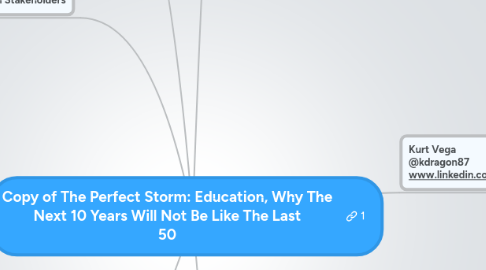
1. Disruptive Change
1.1. How conversations about change often get side-tracked
1.2. Ready or Not
1.3. Like It or Not
1.4. Whether It's Good For Us or Not
1.4.1. Industrial Revolution
2. Education Stakeholders
2.1. Students
2.1.1. Incoming
2.1.2. Under Grad
2.1.3. Grad
2.1.4. Continuing
2.2. Parents
2.3. Educational Insititutions
2.3.1. Faculty
2.3.2. Admin
2.3.3. 3rd Party Institutional support
2.4. Employers
2.5. Government
2.6. Student Loan Debt Holders
2.6.1. Debt Collectors Cashing In on Student Loans
2.7. Non-Students
3. Strategies
3.1. Ignore
3.2. Resist
3.3. Adapt
3.4. Shape
4. Power Shift
4.1. from institutions to
4.1.1. students
4.1.1.1. Web babies
4.1.1.2. incoming wave
4.1.1.2.1. gap between formal and informal learning
4.1.1.3. economic problems
4.1.1.3.1. increasing debt
4.1.1.3.2. weak job market
4.1.1.3.3. cuts in state funding
4.1.1.3.4. Increasing Cost
4.1.1.4. access to information
4.1.1.4.1. free and low cost
4.1.2. 3rd parties
4.1.2.1. Coursera
4.1.2.2. Khan Academy
4.1.2.3. Udacity
4.1.2.4. Reviews
4.1.2.4.1. Khan vs Udacity vs Coursera
4.1.2.5. Accreditation
4.1.2.5.1. MOOC as Courseware
4.1.2.6. Lynda.com
4.2. Social Media
4.3. Value of a degree
4.3.1. questioned
4.3.1.1. NYT
4.3.1.1.1. Saying No to College
4.3.1.2. Forbes
4.3.1.2.1. Is College Worth It?
4.3.1.3. disconnect between degree and ability
4.3.1.4. Peter Thiel
4.3.1.4.1. Will Pay You To Drop Out Of College
4.3.1.4.2. Says College Isn't Needed, but Will Teach at Stanford
4.3.1.5. The Daily Beast
4.3.1.5.1. Is College a Lousy Investment?
4.3.1.6. Time
4.3.1.6.1. Is College Worth It? (Info-graphic)
5. Mid-sized Institutions
5.1. under pressure from
5.1.1. bottom-up
5.1.1.1. Open Source
5.1.1.1.1. can you compete with free?
5.1.1.2. Peer to Peer
5.1.2. top-down
5.1.2.1. large global brands
5.1.2.1.1. MIT
5.1.2.1.2. Stanford
5.1.2.1.3. Harvard
5.1.2.1.4. MOOC's
5.1.3. inability to keep pace with job relevant skills
5.1.3.1. Guestworkers in the high-skill U.S. labor market
5.1.4. 3rd parties(see Power Shift)
